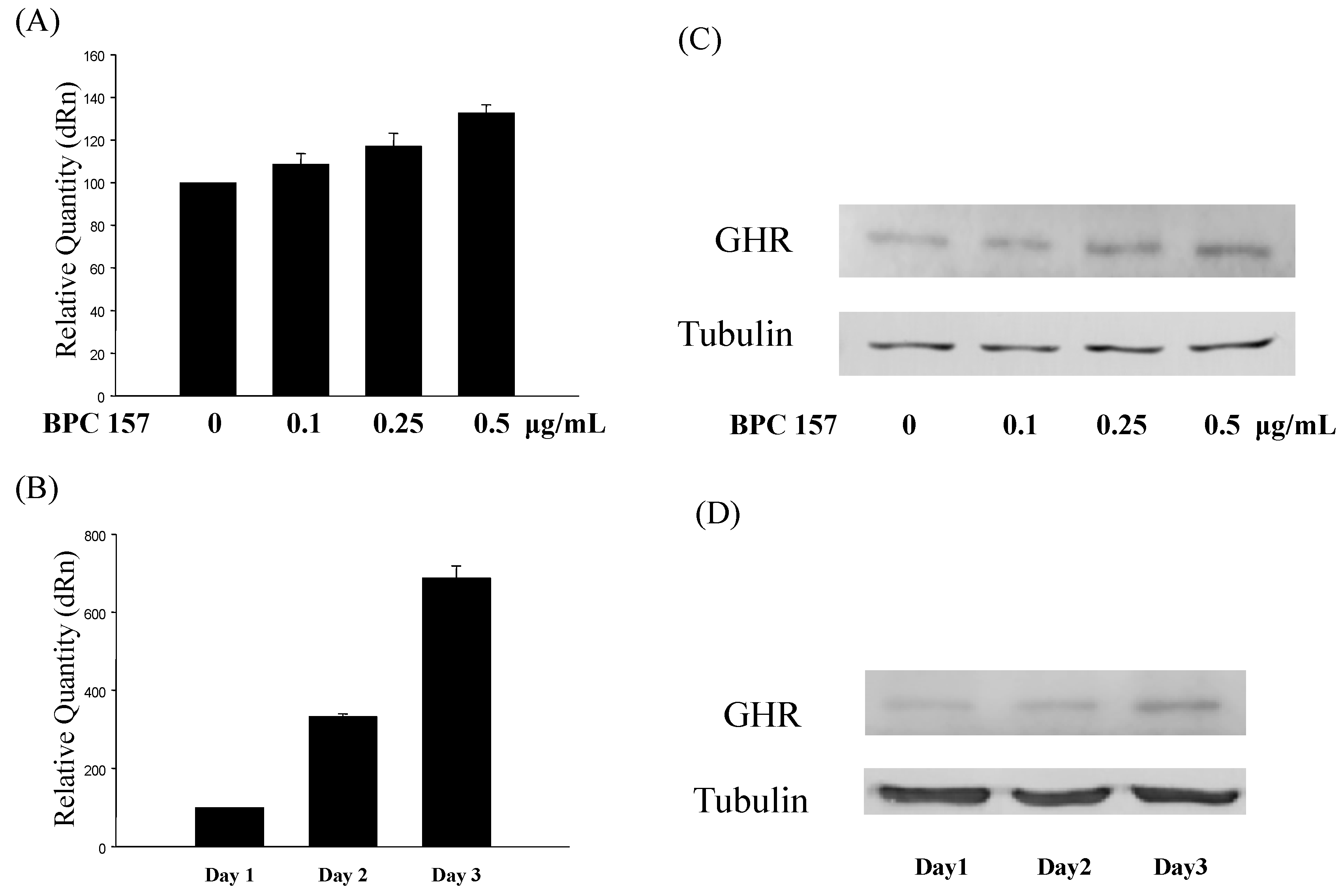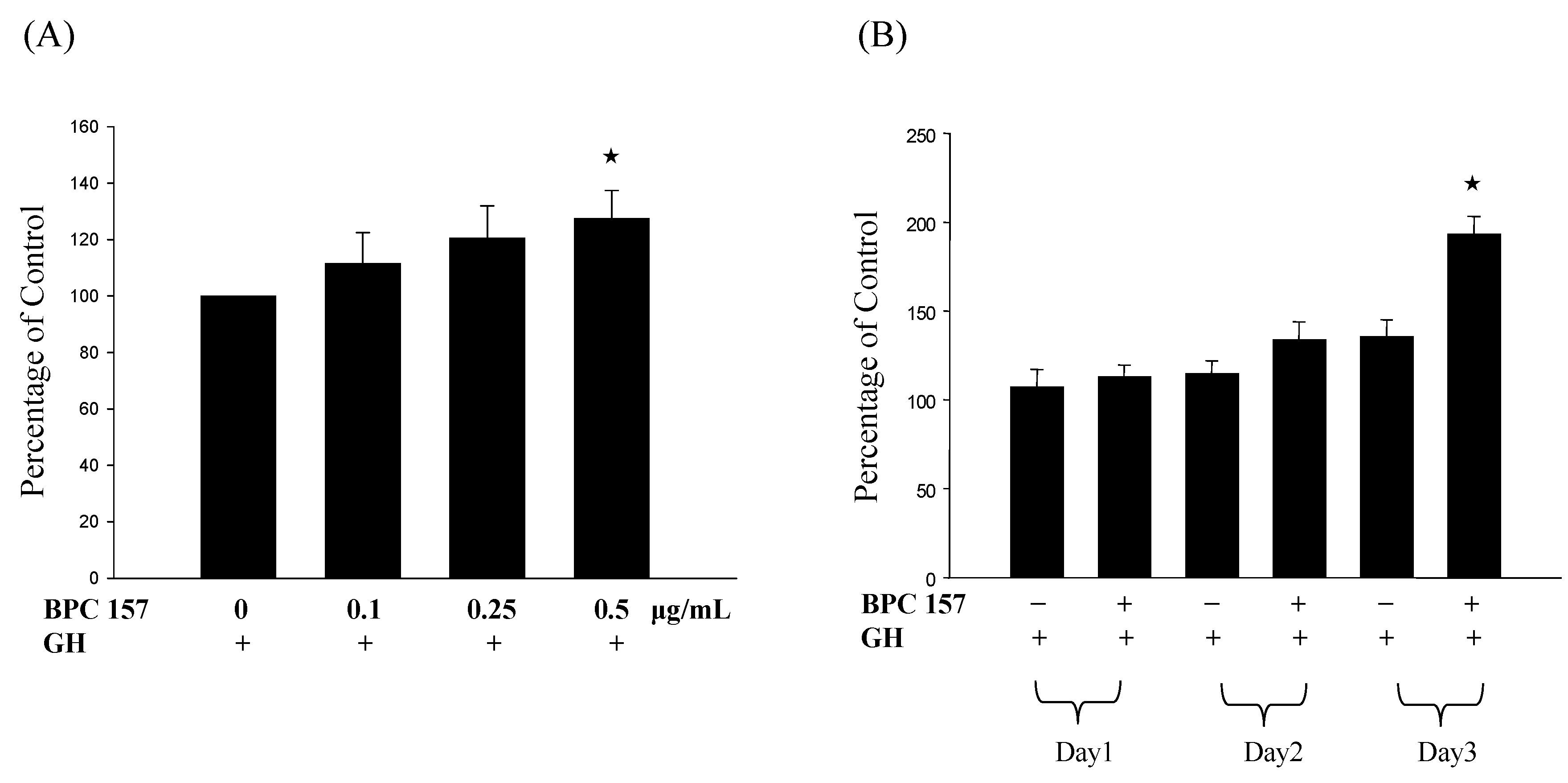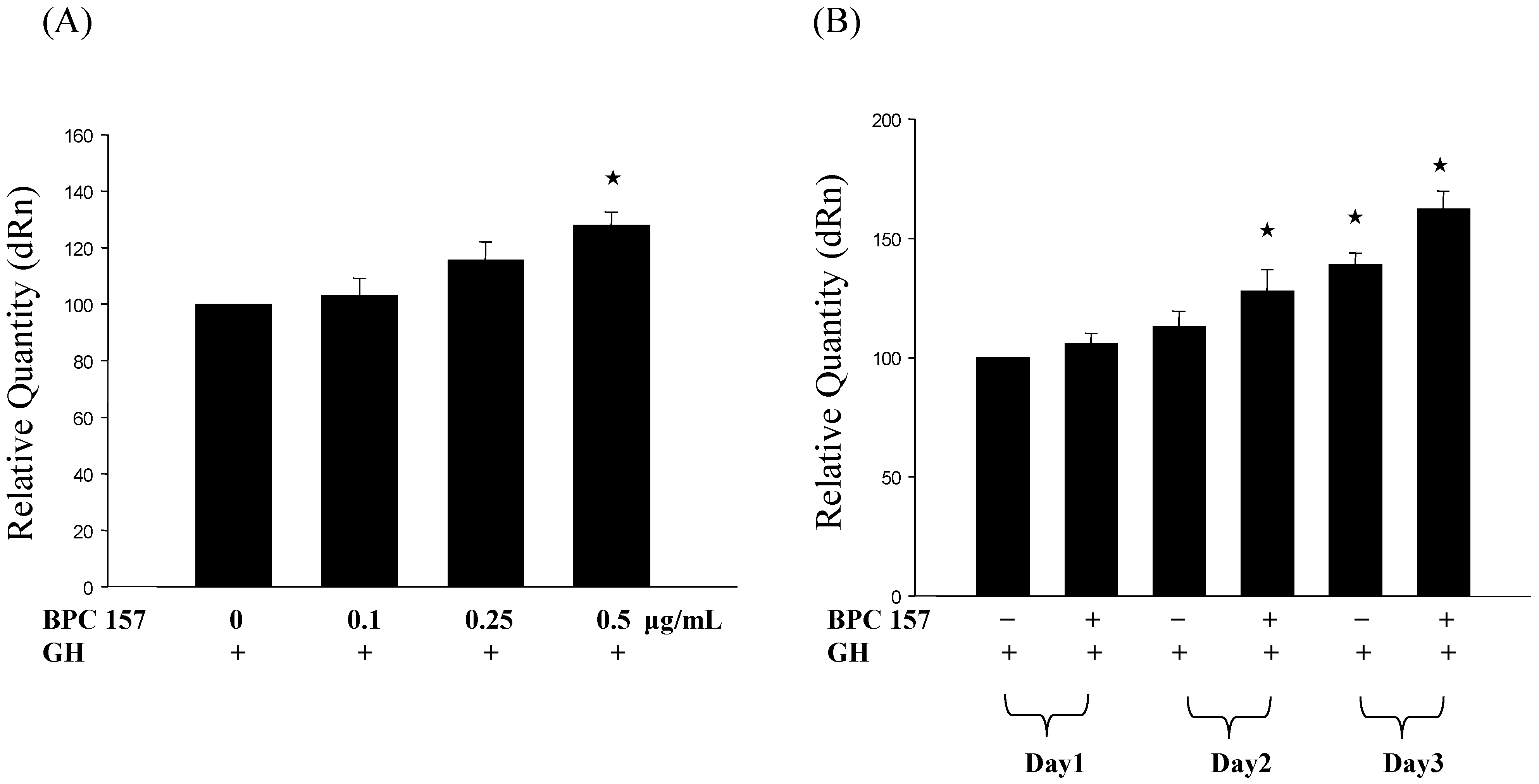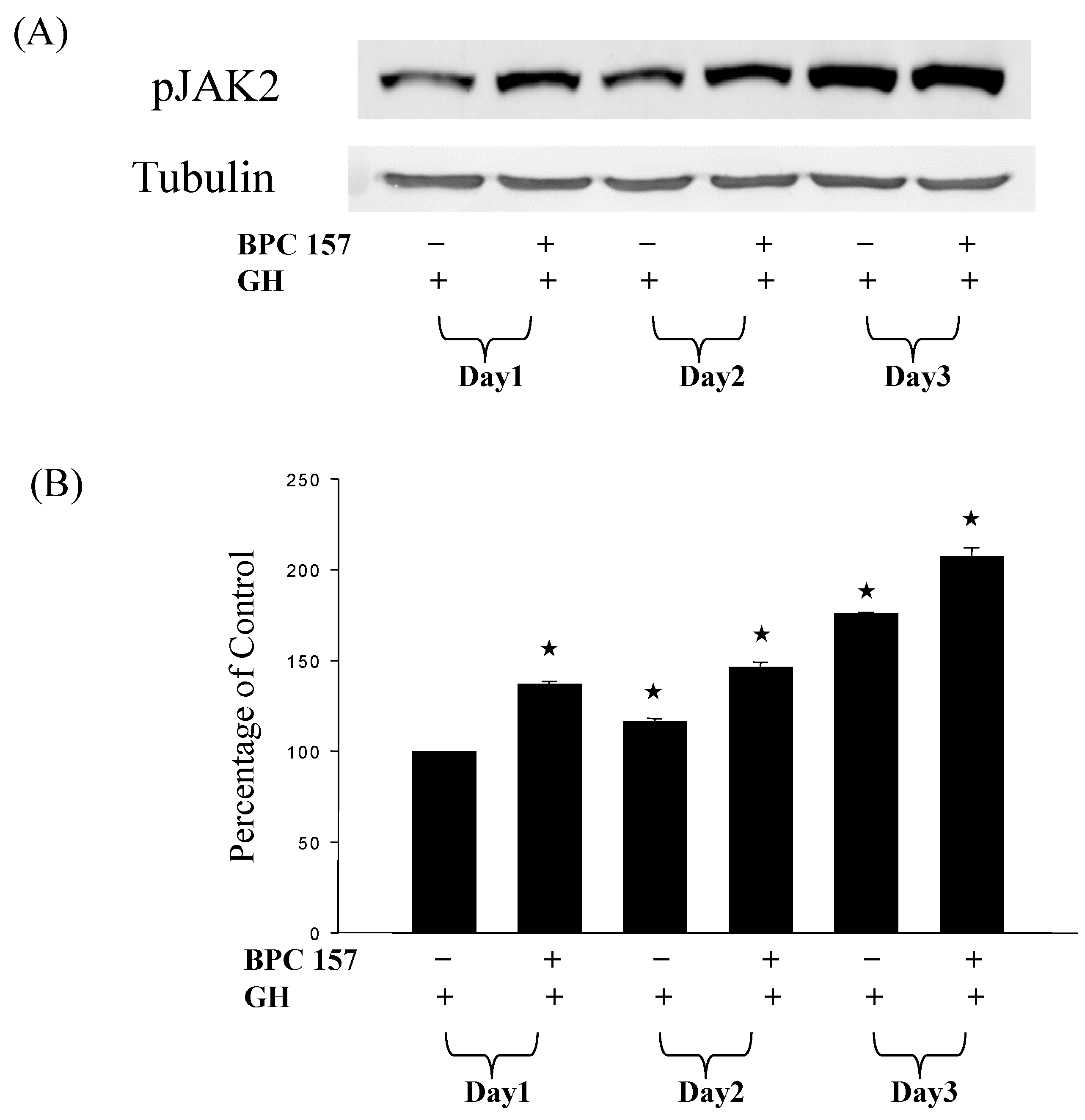Pentadecapeptide BPC 157 Enhances the Growth Hormone Receptor Expression in Tendon Fibroblasts
Abstract
:1. Introduction
2. Results
2.1. BPC 157 Induced the Expression of Growth Hormone Receptor in Tendon Fibroblasts
| Gene | Fold Change |
|---|---|
| HP33 | 7.71 |
| Potassium voltage gated channel, Shaw-related subfamily, member 2 | 3.57 |
| Seminal vesicle antigen-like 1 | 3.47 |
| Retinoblastoma-binding protein 9 | 3.03 |
| cAMP-regulated guanine nucleotide exchange factor II | 2.80 |
| Putative pheromone receptor VN7 | 2.38 |
| Solute carrier family 26 | 2.34 |
| Growth hormone receptor | 2.29 |
2.2. Growth Hormone Increased the Cell Proliferation of BPC 157-Treated Tendon Fibroblasts



2.3. Growth Hormone Activated the Janus Kinase 2 Gene (Jak2) in BPC 157-Treated Tendon Fibroblasts
3. Discussion

4. Experimental Section
4.1. Primary Culture of Tendon Fibroblasts from Rat
4.2. BPC 157 Treatment
4.3. Real-Time PCR
4.4. Western Blot Analysis
4.5. MTT Assay
4.6. Statistical Analysis
5. Conclusions
Acknowledgments
Author Contributions
Conflicts of Interest
References
- O’Brien, M. Functional anatomy and physiology of tendons. Clin. Sports Med. 1992, 11, 505–520. [Google Scholar] [PubMed]
- Yamaguchi, K.; Ditsios, K.; Middleton, W.D.; Hildebolt, C.F.; Galatz, L.M.; Teefey, S.A. The demographic and morphological features of rotator cuff disease. J. Bone Joint Surg. Am. 2006, 88, 1699–1704. [Google Scholar] [CrossRef] [PubMed]
- Beason, D.P.; Soslowsky, L.J.; Karthikeyan, T.; Huard, J. Muscles, Tendons, and Ligaments. In Orthopaedic Knowledge Update 9; Fischgrund, J.S., Ed.; AAOS: Rosemont, IL, USA, 2008; pp. 35–48. [Google Scholar]
- Wolfman, N.M.; Hattersley, G.; Cox, K.; Celeste, A.J.; Nelson, R.; Yamaji, N.; Dube, J.L.; Di Blasio-Smith, E.; Nove, J.; Song, J.J.; et al. Ectopic induction of tendon and ligament in rats by growth and differentiation factors 5, 6, and 7, members of the TGF-β gene family. J. Clin. Invest. 1997, 100, 321–330. [Google Scholar] [CrossRef] [PubMed]
- Aspenberg, P.; Forslund, C. Enhanced tendon healing with GDF 5 and 6. Acta Orthop. Scand. 1999, 70, 51–54. [Google Scholar] [CrossRef] [PubMed]
- Florini, J.R.; Ewton, D.Z.; Coolican, S.A. Growth hormone and the insulin-like growth factor system in myogenesis. Endocr. Rev. 1996, 17, 481–517. [Google Scholar] [PubMed]
- Ohlsson, C.; Bengtsson, B.A.; Isaksson, O.G.; Andreassen, T.T.; Slootweg, M.C. Growth hormone and bone. Endocr. Rev. 1998, 19, 55–79. [Google Scholar] [PubMed]
- Jorgensen, P.H.; Andreassen, T.T.; Jorgensen, K.D. Growth hormone influences collagen deposition and mechanical strength of intact rat skin. A dose-response study. Acta Endocrinol. 1989, 120, 767–772. [Google Scholar] [PubMed]
- Goldstein, R.H.; Poliks, C.F.; Pilch, P.F.; Smith, B.D.; Fine, A. Stimulation of collagen formation by insulin and insulin-like growth factor I in cultures of human lung fibroblasts. Endocrinology 1989, 124, 964–970. [Google Scholar] [CrossRef] [PubMed]
- Granot, I.; Halevy, O.; Hurwitz, S.; Pines, M. Growth hormone and insulin-like growth factor I regulate collagen gene expression and extracellular collagen in cultures of avian skin fibroblasts. Mol. Cell. Endocrinol. 1991, 80, 1–9. [Google Scholar] [CrossRef] [PubMed]
- Doessing, S.; Heinemeier, K.M.; Holm, L.; Mackey, A.L.; Schjerling, P.; Rennie, M.; Smith, K.; Reitelseder, S.; Kappelgaard, A.M.; Rasmussen, M.H.; et al. Growth hormone stimulates the collagen synthesis in human tendon and skeletal muscle without affecting myofibrillar protein synthesis. J. Physiol. 2010, 588, 341–351. [Google Scholar] [CrossRef]
- Brooks, A.J.; Waters, M.J. The growth hormone receptor: Mechanism of activation and clinical implications. Nat. Rev. Endocrinol. 2010, 6, 515–525. [Google Scholar] [CrossRef] [PubMed]
- Bodis, B.; Karadi, O.; Nemeth, P.; Dohoczky, C.; Kolega, M.; Mozsik, G. Evidence for direct cellular protective effect of PL-10 substances (synthesized parts of body protective compound, BPC) and their specificity to gastric mucosal cells. Life Sci. 1997, 61, 243–248. [Google Scholar] [CrossRef]
- Zoricic, I.; Sikiric, P.; Seiwerth, S. Pentadecapeptide BPC-157 beneficially influences the healing of colon-colon anastamoses in rats. In Cell Injury and Protection in the Gastrointestinal Tract. From Basic Science to Clinical Perspectives; Mozsik, G., Nagy, L., Par, A., Rainsford, K., Eds.; Kluwer Academic Publishers: Dodrecht, The Netherlands, 1997; pp. 249–258. [Google Scholar]
- Konjevoda, P.; Nasic, M.; Curkovic, T. Effects of BPC-157 on the healing of corneal lesions. In Uveitis Today; Ohno, S., Aoki, K., Usui, M., Eds.; Elsevier: Amsterdam, The Netherlands, 1998; pp. 311–314. [Google Scholar]
- Sebecić, B.; Nikolić, V.; Sikirić, P.; Seiwerth, S.; Sosa, T.; Patrlj, L.; Grabarević, Z.; Rucman, R.; Petek, M.; Konjevoda, P.; et al. Osteogenic effect of a gastric pentadecapeptide, BPC-157, on the healing of segmental bone defect in rabbits: A comparison with bone marrow and autologous cortical bone implantation. Bone 1999, 24, 195–202. [Google Scholar] [CrossRef] [PubMed]
- Prkacin, I.; Aralica, G.; Perovic, D.; Separovic, J.; Gjurasin, M.; Lovric-Bencic, M.; Stancic-Rokotov, D.; Ziger, T.; Anic, T.; Sikiric, P.; et al. Chronic cytoprotection: Pentadecapeptide BPC 157, ranitidine and propranolol prevent, attenuate and reverse the gastric lesions appearance in chronic alcohol drinking rats. J. Physiol. Paris 2001, 95, 295–301. [Google Scholar] [CrossRef] [PubMed]
- Mikus, D.; Sikiric, P.; Seiwerth, S.; Petricevic, A.; Aralica, G.; Druzijancic, N.; Rucman, R.; Petek, M.; Pigac, B.; Perovic, D.; et al. Pentadecapeptide BPC 157 cream improves burn-wound healing and attenuates burn-gastric lesions in mice. Burns 2002, 27, 817–827. [Google Scholar] [CrossRef]
- Staresinic, M.; Sebecic, B.; Patrlj, L.; Jadrijevic, S.; Suknaic, S.; Perovic, D.; Aralica, G.; Zarkovic, N.; Borovic, S.; Srdjak, M.; et al. Gastric pentadecapeptide BPC 157 accelerated healing of transected rat Achilles tendon and in vitro stimulates tenocytes growth. J. Orhtop. Res. 2003, 21, 976–983. [Google Scholar] [CrossRef]
- Xue, X.C.; Wu, Y.J.; Gao, M.T.; Li, W.G.; Zhao, N.; Wang, Z.L.; Bao, C.J.; Yan, Z.; Zhang, Y.Q. Protective effects of pentadecapeptide BPC 157 on gastric ulcer in rats. China World J. Gastroenterol. 2004, 10, 1032–1036. [Google Scholar]
- Bilic, M.; Bumber, Z.; Blagaic, A.B.; Batelja, L.; Seiwerth, S.; Sikiric, P. The stable gastric pentadcapeptide BPC 157, given locally, improve CO2 laser healing in mice. Burns 2005, 31, 310–315. [Google Scholar] [CrossRef] [PubMed]
- Staresinic, M.; Petrovic, I.; Novinscak, T.; Jukic, I.; Pevec, D.; Suknaic, S.; Kokic, N.; Batelja, L.; Brcic, L.; Boban-Blagaic, A.; et al. Effective therapy of transected quadriceps muscle in rat: Gastric pentadecapeptide BPC 157. J. Orthop. Res. 2006, 24, 1109–1117. [Google Scholar] [CrossRef] [PubMed]
- Krivic, A.; Anic, T.; Seiwerth, S.; Huljev, D.; Sikiric, P. Achilles detachment in rat and stable gastric pentadecapeptide BPC 157: Promoted tendon-to-bone healing and opposed corticosteroid aggravation. J. Orthop. Res. 2006, 24, 982–989. [Google Scholar] [CrossRef] [PubMed]
- Klicek, R.; Sever, M.; Radic, B.; Drmic, D.; Kocman, I.; Zoricic, I.; Vuksic, T.; Ivica, M.; Barisic, I.; Ilic, S.; et al. Pentadecapeptide BPC 157, in clinical trials as a therapy for inflammatory bowel disease (PL14736), is effective in the healing of colocutaneous fistulas in rats: Role of the nitric oxide-system. J. Pharmacol. Sci. 2008, 108, 7–17. [Google Scholar] [CrossRef]
- Sikiric, P.; Seiwerth, S.; Brcic, L.; Blagaic, A.B.; Zoricic, I.; Sever, M.; Klicek, R.; Radic, B.; Keller, N.; Sipos, K.; et al. Stable gastric pentadecapeptide BPC 157 in trials for inflammatory bowel disease (PL-10, PLD-116, PL 14736, Pliva, Croatia). Full and distended stomach, and vascular response. Inflammopharmacology 2006, 14, 214–221. [Google Scholar] [CrossRef]
- Sikiric, P.; Petek, M.; Rucman, R.; Seiwerth, S.; Grabarević, Z.; Rotkvić, I.; Jagić, V.; Turković, B.; Mildner, B.; Duvnjak, M.; et al. The significance of the gastroprotective effect of body protection compound (BPC): Modulation by different procedures. Acta Physiol. Hung. 1992, 80, 89–98. [Google Scholar]
- Molloy, T.J.; Wang, Y.; Horner, A.; Skerry, T.M.; Murrell, G.A. Microarray analysis of healing rat Achilles tendon: Evidence for glutamate signaling mechanisms and embryonic gene expression in healing tendon tissue. J. Orthop. Res. 2006, 24, 842–855. [Google Scholar] [CrossRef] [PubMed]
- Khan, A.S.; Sane, D.C.; Wannenburg, T.; Sonntag, W.E. Growth hormone, insulin-like growth factor-1 and the aging cardiovascular system. Cardiovasc. Res. 2002, 54, 25–35. [Google Scholar] [CrossRef] [PubMed]
- Chang, C.H.; Tsai, W.C.; Lin, M.S.; Hsu, Y.H.; Pang, J.H. The promoting effect of pentadecapeptide BPC 157 on tendon healing involves tendon outgrowth, cell survival, and cell migration. J. Appl. Physiol. 2011, 110, 774–780. [Google Scholar] [CrossRef] [PubMed]
- Rosenfeld, R.G.; Hwa, V. The growth hormone cascade and its role in mammalian growth. Horm. Res. 2009, 71 (Suppl. 2), 36–40. [Google Scholar]
- Taub, D.D.; Tsarfaty, G.; Lloyd, A.R.; Durum, S.K.; Longo, D.L.; Murphy, W.J. Growth hormone promotes human T cell adhesion and migration to both human and murine matrix proteins in vitro and directly promotes xenogeneic engraftment. J. Clin. Invest. 1994, 94, 293–300. [Google Scholar] [CrossRef] [PubMed]
- Savino, W. Neuroendocrine control of T cell developmentin mammals: Role of growth hormone in modulating thymocyte migration. Exp. Physiol. 2007, 92, 813–817. [Google Scholar] [CrossRef] [PubMed]
- Lee, S.W.; Kim, J.Y.; Lee, Y. The effect of growth hormone on fibroblast proliferation and keratinocyte migration. J. Plast. Reconstr. Aesthet. Surg. 2010, 63, 364–369. [Google Scholar] [CrossRef]
- Sample Availability: Samples of BPC 157 are available from the authors.
© 2014 by the authors. Licensee MDPI, Basel, Switzerland. This article is an open access article distributed under the terms and conditions of the Creative Commons Attribution license ( http://creativecommons.org/licenses/by/4.0/).
Share and Cite
Chang, C.-H.; Tsai, W.-C.; Hsu, Y.-H.; Pang, J.-H.S. Pentadecapeptide BPC 157 Enhances the Growth Hormone Receptor Expression in Tendon Fibroblasts. Molecules 2014, 19, 19066-19077. https://doi.org/10.3390/molecules191119066
Chang C-H, Tsai W-C, Hsu Y-H, Pang J-HS. Pentadecapeptide BPC 157 Enhances the Growth Hormone Receptor Expression in Tendon Fibroblasts. Molecules. 2014; 19(11):19066-19077. https://doi.org/10.3390/molecules191119066
Chicago/Turabian StyleChang, Chung-Hsun, Wen-Chung Tsai, Ya-Hui Hsu, and Jong-Hwei Su Pang. 2014. "Pentadecapeptide BPC 157 Enhances the Growth Hormone Receptor Expression in Tendon Fibroblasts" Molecules 19, no. 11: 19066-19077. https://doi.org/10.3390/molecules191119066




